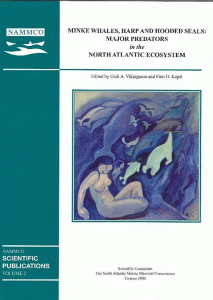Volume 2: Predators in the North Atlantic
Minke whales, harp and hooded seals: major predators in the North Atlantic ecosystem
Harp seals (Phoca groenlandica), hooded seals (Cystophora cristata) and minke whales (Balaenoptera acutorostrata) are top predators in the North Atlantic Ocean. In late winter, harp and hooded seals migrate to geographically well defined pack ice areas to whelp, breed and moult. During the rest of the year they disperse widely in the North Atlantic between Canada, Greenland and North Europe in search of their prey of various fish and invertebrate species. The migration pattern of minke whales is poorly understood, although they are believed to migrate between high latitude summer feeding areas and breeding areas at lower latitudes in winter. These three species are among the most abundant marine mammals, in terms of numbers and biomass, in the North Atlantic and Arctic, and hence can be expected to play an important role as predators in this ecosystem.
Humans are also top predators in the North Atlantic ecosystem. They exploit the populations of fish and crustaceans of the North Atlantic extensively, and also exploit the harp seal, hooded seal and minke whale populations. The commercial exploitation of these three marine mammals was previously much more intense, which led to criticism and demands for tighter regulation. Quotas were introduced, and since the 1970s, a major research effort has been devoted to the assessment of the status and productivity of the stocks. It is evident that the stocks of these species are at or near historically high levels, and that some of them may still be expanding quite rapidly. This gives rise to a new concern: will these large and expanding stocks lead to increasing competition with man for other marine fisheries resources?
In 1996, the NAMMCO Council asked the Scientific Committee “to focus its attention on the food consumption of three predators in the North Atlantic: the minke whale, the harp seal and the hooded seal, with a particular emphasis on the study of the potential implications for commercially important fish stocks.” In response, the Scientific Committee formed a Working Group on the Role of Minke Whales, Harp Seals and Hooded Seals in North Atlantic Ecosystems, which met in Tromsø, Norway in March 1997. The Working Group included members of the Scientific Committee and invited experts from Canada, Denmark, Iceland and Norway. The working papers developed for this meeting formed the basis of this volume, but other contributions relevant to the focus of the volume are included as well.
The volume includes 5 papers descriptive of the diets of these species in parts of the Northeast, Central and Western Atlantic. Two papers provide estimates of the total consumption of harp seals and minke whales in the Barents and Norwegian seas. The volume concludes with two papers which discuss the potential predatory and competitive interactions of these species with important fish stocks in the Northeast Atlantic.
This volume is edited by Gísli A. Víkingsson, Senior Scientist at the Marine Research Institute, Reykjavik, Iceland, and Finn O. Kapel, former Deputy Director of Greenland Institute of Natural Resources, now retired.



